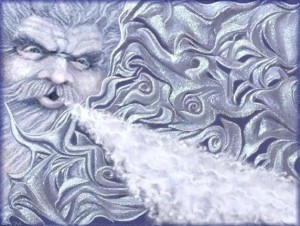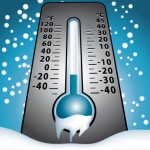
Seasonal changes can represent challenges for many koi pond and water garden owners. Some pond owners may even have to deal with drastic changes for each season. Sub-zero brutal winter temperatures thawing into the soaking rains of Spring time. Spring time very quickly transforms into a Summer of heat waves, drought, and soaring temperatures. And before Ol’ Man Winter starts bellowing again the Autumn time dumps massive amounts of material into our yards, koi ponds, and water gardens. As pond owners it seems we need to have a game plan every few months!
Since winter time in many areas can represent some particularly challenging conditions for koi ponds and water gardens, let’s touch on some tips for winter pond care. Winter is a time that not enough of us pond owners are enjoying our ponds natural beauty. It’s understandably since sometimes the conditions just won’t permit it. Since contact could be limited with your pond here are a few things to keep in mind for your winter pond care.
Try to start the winter with a clean pond. October is a great time to get your winter pond prep done. Leaf netting placed over your pond is very helpful this time of year, and can come off in a few weeks. As temperatures dip and drop be sure to have your de-icer and aerator installed; sometimes those overnight temperature dips can catch you off guard. This is typically time to stop feeding your koi and goldfish as well.
When winter really blows in ice and snow become considerations in your pond care. When koi ponds and water gardens ice over it typically starts at the edge of the pond and slowly creeps inward over the entire pond. Ice cover is ok in ponds 18” and deeper in most cases. Properly functioning de-icers and aerators will keep an opening in the ice cover all the way down to the single digit temperatures (F). Single digit temperatures should be considered extreme conditions. 
If you have a waterfall try not to allow the water to flow over any ice that may have formed in the waterfall or pond; try to keep the water flowing below ice cover. Water that flows over ice can become much colder than the pond water itself, which can drive down temperatures within the pond; which is NOT desirable. Water flowing over ice into your pond should be stopped when you encounter it asap!
If you find yourself caught off guard with extreme weather and icing conditions do not try to break a hole in your ice. Ice even 1” thick is a very difficult material to break through, imagine trying to break through 5” of ice! For extreme conditions like this a hole saw will come in very handy. Instead of stressing your fish and yourself out with the exhausting chore of hacking through the ice with that hand hatchet from your shed, try using a 4” hole saw (found at any big box home store) that will cut a very nice hole in the ice, with minimal effort, which you can drop some air lines down through.
When aerating a winter pond try to start with fresh new air diffusers. When placing the diffusers into the pond do not go too deep. If you have shelves in your pond place the diffusers on the shallowest shelf. Whatever the case, since so many ponds have different configurations, try to avoid placing the diffuser on the bottom of the pond. During colder winter months the water on the bottom of the pond should not be moved to the top of the pond that much, since an effect of “super cooling” the pond can happen; much like what happens when water flows over ice into your pond.
After heavy snow fall remove some or all of the snow from your water garden koi pond to allow for some sunlight to get into the pond. This is not a critical task, however; don’t leave your fish and plants in the dark for too long. Snow removal from your pond also improves safety around the pond when it cannot be seen under snow cover; we don’t want people, pets, or critters falling into your pond this time of year so let them know the pond is there. An open pond also provides a nice source of water for small or not so small birds and animals in your area.
These are just a few tips to keep in mind during those winter months. There are many other things to observe and enjoy about your pond during this time of year. Every koi pond and water garden will have specific considerations as well. With these few winter care pond tips you can look forward to the winter months, and actually take time to enjoy the amazing conditions that winter can bring along with it. Enjoy the dynamic and natural beauty of your pond this winter!
Mike Gannon is author of the LOVEYOUROND blog and owner at Full Service Aquatics located in Summit, NJ USA.

My fish are very confused. In Pennsylvania, we had zero temp with a windchill of 25 below then a day later it is 50 degrees. Crazy winter that is for sure. They don’t know what the heck is going on. They are swimming under thin ice. haha.
Ha! We get some wild swings here in the Northeast! Hope the fish are doing well!
Hello Mike,
I inherited a pond when we bought our home in upstate New York. After clearing out the 8′ x 15′ lower pond of overgrown cat tails and building a 4′ x 4′ upper pond with waterfall I’m concerned about winter. The max depth is 26″ with an average depth of 18″ my intention is to shut down the pump and filter and place all the fish below. What will I need to insure that my comets and Golden Orfe Will survive the winter?
Hey Jeff, thanks for reaching out. Your fish will likely do pretty well during winter even though it can get pretty rough up your way! I’d recommend getting yourself a really good pond aerator, and a de-icer for your winter months. With that set-up you should do pretty good. Good luck!! -Mike
My neighbor is away and his koy pond has been under extreme weather temperature and I just noticed that their all floating on surface are they still in Hibernating or Dead?
Hi Michael. Thanks for reaching out, and looking out for your neighbor. I, unfortunately, think the koi are likely dead if they are floating in the pond. If they are in fact dead, and you want to help the surviving fish, the dead ones should come out of the pond before the begin to decay and foul the water… wish I had a better outlook on it. -Mike